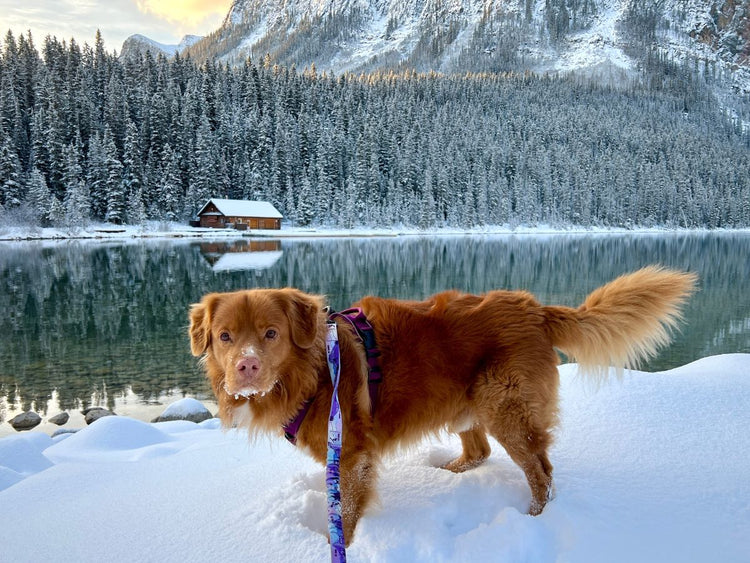Just because the temperature has fallen doesn’t mean you have to stop exploring! In fact, winter hiking offers breathtaking views and may even help you find more solitude on the trail as fewer people are venturing out. Read ahead for some tips on how to stay warm and prepared on the trail.

Prepare: Like any hiking trip, it’s necessary to be prepared, especially as you may encounter some pretty harsh conditions. It’s also important to help your dog acclimate to the weather and ensure that your pup has the proper level of fitness for the strenuous activity.
Dogs Age: Also keep in mind that hiking isn’t recommended for puppies or older dogs who can tire more easily, so be sure to chat to your vet to find out what your dog is capable of before undertaking a huge hike. You’ll also want to be even more vigilant of the weather conditions during the winter: think not only about how the weather might change while you’re out but what the current conditions are on the trail.
Activity Level: Snow drifts and too much fresh powder on the hiking trail can mean that your dog needs to jump through the snow which isn’t the ideal, especially for a longer hike as this will become exhausting very quickly. Once you have checked with your vet and know that your dog is ready to take on a winter hike, you can head out with these tips in mind.

Our 11 essentials for winter hiking:
1. Identification
Although it might seem rather obvious, it’s vital that your dog has I.D. in case the unimaginable happens and you do get separated while hiking. Make sure that your cell phone number rather than your home phone number is on their collar so that you’re able to be contacted. Our ID Tag Sets are custom made and fully personalizable for your pup!
If your dog has a microchip, you’ll also want to ensure that your information on file is up-to-date. To help keep worries at bay, you also may want to consider investing in a dog GPS system like Whistle (bonus: you’ll get stats about just how strenuous that hike really was!) or a location beacon like this one from SportDog.
2. Leash and Harness
Many National Parks require dogs to be leashed at all times and so it’s essential to have a good quality leash on hand to be considerate of other people and wildlife on the trail. A leash with a waist attachment like our All-Mountain Dog Leash is perfect for hiking as it allows you to be hands-free while still having control over your dog.
A harness such as our Kootenay Harness is also a great option to bring for hiking as it won’t pull or choke your dog should they get caught up on something or you take a tumble. If you do choose to go with a collar, we suggest opting for a quick-dry collar should your dog get wet from the snow, as well as a quick-release collar to keep your dog safe as they navigate past branches.

3. Nutrition A. Water
Just like you need energy bars and water, your dog needs great nutrition, too. Although it might seem less intuitive in the colder weather, hydration is super important for dogs, especially because they don’t sweat.
Plus, while you might rely on streams and rivers during the summer for water, these are frozen or dry during the winter months so you’ll need to be prepared with your own water supply to avoid dehydration.
And if you’re thinking your dog will be able to keep their thirst quenched by munching on fresh snow, snow actually isn’t an adequate source of hydration as it requires too much energy for your dog’s body (and yours!) to warm up to body temperature. Use an insulated water bottle or wrap your water in extra clothes to keep it from freezing in your pack. Our RMD Hydra bottle is small and lightweight for day use. Its also a great option to pack dog treats inside so you do not have to remove your gloves to feed your dog a snack.

B. Food
You’ll also need to take food for your dog as well as treats to help them keep up their calories while also giving them an incentive to follow the rules of the trail.
Keep in mind that hiking in snow is more exhausting than hiking during moderate weather, so you’ll need to pack enough nutrient-dense food to get you through your journey; your dog may need 50-100% more calories while hiking to deal with the increased energy demands, so pack accordingly! Our favorite hiking snack for dogs is the Ruff Bar. Its packed with protein so your dog will be able to sustain the full hike.
Just remember that food and treats may freeze in the cold weather, so keep them close to your body to allow your body heat to keep them warm. Make sure you pack a travel bowl so your dog is able to lap their water: our Collapsible Dog Travel Bowl is perfect as it’s super lightweight and easy to pack and has space for both food and water.

4. Paw Protection
While you may think that your pup’s paws are built for anything, this just isn’t true. Dog’s paws can crack and chap as our lips and hands do in the cooler weather. You can help to protect their paws against this with our Organic Paw Cream that is handmade here in Calgary!
However, paw wax doesn’t protect your dog against the danger of them cutting their paw on a sharp rock or rough terrain, nor does it prevent snow and ice from building up between your dog’s paw pads, which can be painful.
For this, you might want to consider outfitting your dog with a pair of dog boots - or at least have them in your pack should you encounter extreme weather conditions to provide extra protection and warmth in the cold weather. Be sure they fit properly so snow isn’t getting in, and get your dog used to wearing boots before you head out.

5. First Aid Kit
When you’re in the wilderness, it’s important to be prepared for whatever might happen: both for yourself and your pup. One of the most important things to put in this kit is the number of your vet as well as contacts for nearby vet emergency clinics should you need it.
If you want to keep things simple, you can purchase a complete first kit or assemble what you need yourself. Some of this might overlap with your human first aid kit including hydrogen peroxide, antibiotic ointment, gauze, and scissors.
Specifically for your dog, you might want to add a styptic pencil to stop bleeding and doggy aspirin for pain relief, as well as any information you need about pet first aid, especially about hypothermia and dehydration. A first aid kit is only helpful if you know how to use the supplies inside.
6. Warmth & Protection
Shorter, leaner dog breeds and those with shorter hair are more likely to need extra help with staying warm but in extreme temperatures, all dogs could use more than just their natural fur coat to stay warm.
A winter dog coat will also help them to stay dry and protect their fur and skin from the elements, making a great thing to have on hand, especially if the weather changes quickly during your hike.
We recommend our Glacier Insulated Dog Parka because it’s easy to put on and take off. It is built specifically for winter so it’s both waterproof and windproof, while the fleece lining helps to work with your dog’s natural body heat to keep them warm. Plus, it has built-in reflectors, so you don’t have to worry about your dog being visible while they’re wearing it.

7. U.V. Protection
U.V. protection and sunglasses seem like an obvious necessity for summertime, but it’s just as important during the wintertime as sunlight can bounce off the snow and reflect back into your dog’s eyes, much like it would for you when you’re out skiing or snowboarding.
We recommend RexSpec’s Dog Goggles which protect your dog’s eyes from the sun as well as other debris while still allowing full visibility. Plus, they’ll protect your dog from the irritation that blowing snow can cause.
8. Visibility
Seeing your dog while hiking is important - both for yourself and for those who are on the trail around you. Keep your dog visible with Mountain Beacon LED Safety Collar, which can be set to glow, blink, or flash to keep your dog safe.
Outfitting your dog in bright clothing is also helpful to see them in snowy conditions or the low light of winter, and is an absolute necessity should you be hiking in a hunting area.
You might also want to throw a flashlight in your pack because the light can fade so quickly during the winter. Of course, you’ll want to make sure that you are not only seen but also heard. If you’re not keeping your dog on a leash, you might want to consider getting a bear bell for their collar to help alert other trail users and animals of their presence.
![]()
9. Down Sleeping Bag
While you’re able to take a break on a dry tree stump or rock or your backpack, your dog isn’t able to, which is why a warm and cosy sleeping bag is important to help them take a load off and warm-up, especially if you plan to stop at a viewpoint or to have a snack.
It can also be an essential part of your wilderness first aid kit as an injured pet can slip into shock, so this is a great way to help keep them warm. Our Sleeping Bag for dogs is a great option as it's super packable but with fleece inner lining and extra soft filling it's also super warm. If you don’t plan to use it on your hike, it’s a good idea to stash in the car to help your dog warm up on the way home.

10. Dog Carrying Backpack
If your dog loves to come hiking with you but can't sustain walking for the whole hike the K9 Sport Sack is the perfect alternative to them staying home. You'll want to get your dog used to the pack before heading out. Taking it out regularly to get them familiar and doing short walks before attempting a long hike. There are 3 different packs and they vary in size carrying up to 50lbs.

11. Have a Plan B
With so many unexpected things that can happen in the winter, it’s important that a plan B be part of your winter hiking essentials. Keep in mind how long your dog can stay out with the current temperature. While this can depend on breed, you’ll want to watch out for signs it's too cold like shivering, acting anxious, and seeking out warmer places.
Have a shorter trail in mind in the case it’s too cold or the snow is too high. If worse comes to worst, you might want to ditch your winter hike for another outdoor activity like nose work or having a snowball fight in your yard or a local park where you’re closer to the warmth of home.



